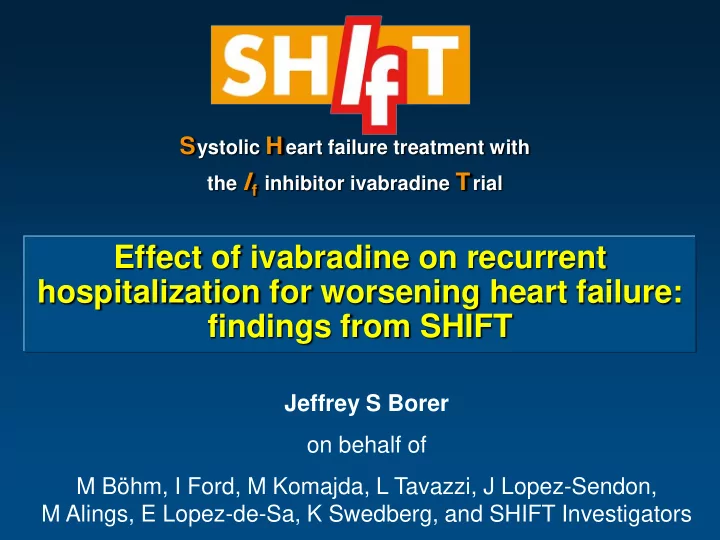

S ystolic H eart failure treatment with the I f inhibitor ivabradine T rial Effect of ivabradine on recurrent hospitalization for worsening heart failure: findings from SHIFT Jeffrey S Borer on behalf of M Böhm, I Ford, M Komajda, L Tavazzi, J Lopez-Sendon, M Alings, E Lopez-de-Sa, K Swedberg, and SHIFT Investigators
Disclosures All authors have received honoraria or research grants from Servier The study was supported by Servier, France
Trial design Randomized, double-blind, placebo-controlled trial in 6505 patients to test the hypothesis that heart rate slowing with the I f inhibitor ivabradine improves cardiovascular outcomes in patients with: • Moderate to severe chronic heart failure (HF) • Hospitalization for worsening HF within the 12 months prior to randomization Left ventricular ejection fraction ≤ 35% • Sinus rhythm and heart rate ≥ 70 bpm • • Receiving guidelines-based background HF therapy Swedberg K, et al. Lancet 2010;376: 875-885 .
Primary endpoint: c omposite of CV death or hospitalization for heart failure Cumulative frequency (%) 40 HR (95% CI), 0.82 (0.75–0.90) Placebo - 18% p <0.0001 30 Ivabradine 20 10 0 0 6 12 18 24 30 Months Swedberg K, et al. Lancet 2010;376: 875-885.
Secondary pre-specified endpoint: hospitalization for heart failure Hospitalization for HF (%) 30 Placebo HR (95% CI), 0.74 (0.66;0.83) - 26% p <0.0001 20 Ivabradine 10 0 0 6 12 18 24 30 Months Swedberg K, et al. Lancet 2010;376: 875-885.
Objective of the current analysis To assess the effect of heart rate slowing with ivabradine on recurrent hospitalizations for worsening heart failure
Economic burden of chronic HF Primary Care Post-discharge outpatient visits 2% 6% 5% Outpatient referral Hospital admissions 18% Drug treatment 69% Hospitalization accounts for most CHF-associated costs Stewart S et al. Eur J Heart Fail 2002;4:361–71.
Analysis plan Effect of ivabradine on • total hospitalizations : incidence rate ratio vs placebo • repeated hospitalizations : - total-time approach (time from randomization to 1 st , 2 nd and 3 rd hospitalization) - gap-time approach (time from 1 st to 2 nd hospitalization) All approaches adjusted for protocol-specified prognostic factors present pre-randomization (beta-blocker intake, NYHA class, ischaemic cause of HF, LVEF, age, SBP, HR, creatinine clearance)
Pre-randomization characteristics Number of hospitalizations for HF during trial p -value None One Two Three or > (n=5319) (n=714) (n=254) (n=218) Age (years) <0.0001 60.0 62.3 61.8 62.4 Male (%) 77 74 77 81 0.18 Heart rate (bpm) <0.0001 79.3 82.2 83.4 82.2 SBP (mmHg) <0.0001 122.3 119.8 118.1 117.6 DBP (mmHg) 76.0 75.0 73.4 73.3 <0.0001 LVEF (%) <0.0001 29.3 27.6 27.8 27.1 NYHA class II (%) <0.0001 51 38 38 34 NYHA class III/IV (%) 49 62 62 66 Duration of HF (years) 3.3 4.2 4.3 4.6 <0.0001 Diabetes (%) 29 35 35 40 <0.0001
Pre-randomization background treatment Number of hospitalizations for HF during trial p -value None One Two Three or > (n=5319) (n=714) (n=254) (n=218) <0.0001 90 89 80 86 Beta-blockers (%) 91 89 90 93 0.13 ACEI and/or ARB (%) <0.0001 58 69 67 73 MRA (%) <0.0001 82 90 90 95 Diuretics (%) 20 30 33 35 <0.0001 Digitalis (%)
Effect of ivabradine on total HF hospitalizations Cumulative incidence of HF hospitalizations (first and repeated) IRR (95% CI), 0.75 (0.65;0.87) P= 0.0002 40 Placebo - 25% 30 Ivabradine 20 10 0 0 6 12 18 24 30 Time (months)
Recurrence of HF hospitalization Total-time approach Hazard p -value Ivabradine Placebo ratio (n=3241) (n=3264) First 514 (16%) 672 (21%) 0.75 p<0.001 hospitalization Second hospitalization 189 (6%) p<0.001 283 (9%) 0.66 Third hospitalization 90 (3%) 128 (4%) p=0.012 0.71 1.0 0.4 0.6 0.8 1.2 Favours placebo Favours ivabradine
Recurrence of HF hospitalizations Gap-time approach = Time from 1 st to 2nd hospitalization Cumulative frequency (%) HR (95% CI), 0.84 (0.69–1.01) Placebo 70 P= 0.058 60 50 Ivabradine 40 30 20 10 0 0 6 24 12 Time from first hospitalization (months) 472 patients with at least a first and second hospitalisation for worsening HF
Total number of hospitalizations Ivabradine Placebo IRR p -value 95% CI (N=3241) (N=3264) Hospitalization for 902 1211 0.75 0.65-0.87 0.0002 worsening HF Hospitalization for 2661 3110 0.85 0.78-0.94 0.001 any cause Cardiovascular 1909 2272 0.84 0.76-0.94 0.002 hospitalisation Hospitalization for 1759 1899 0.92 0.83-1.02 0.12 other than worsening of HF
Limitations Both of the statistical models have well known limitations total-time approach: treatment effect dependent on previous hospitalizations (cumulative effect) gap-time approach: restricted set of patients; therefore, randomization not preserved Data on hospitalization burden may be influenced by differences between health care systems in different countries
Conclusion Heart rate reduction with ivabradine in patients with chronic HF, in sinus rhythm, with heart rate ≥70 bpm and already receiving guidelines-suggested therapies substantially decreases the risk of clinical deterioration as reflected by: • reduction in the total hospitalizations for worsening HF • reduction in the incidence of recurrent HF hospitalizations • increase in time to first and subsequent hospitalizations This benefit reduces the total burden of HF for the patient and can be expected to substantially reduce health care costs
Available online now Will be replaced with the final version
Recommend
More recommend